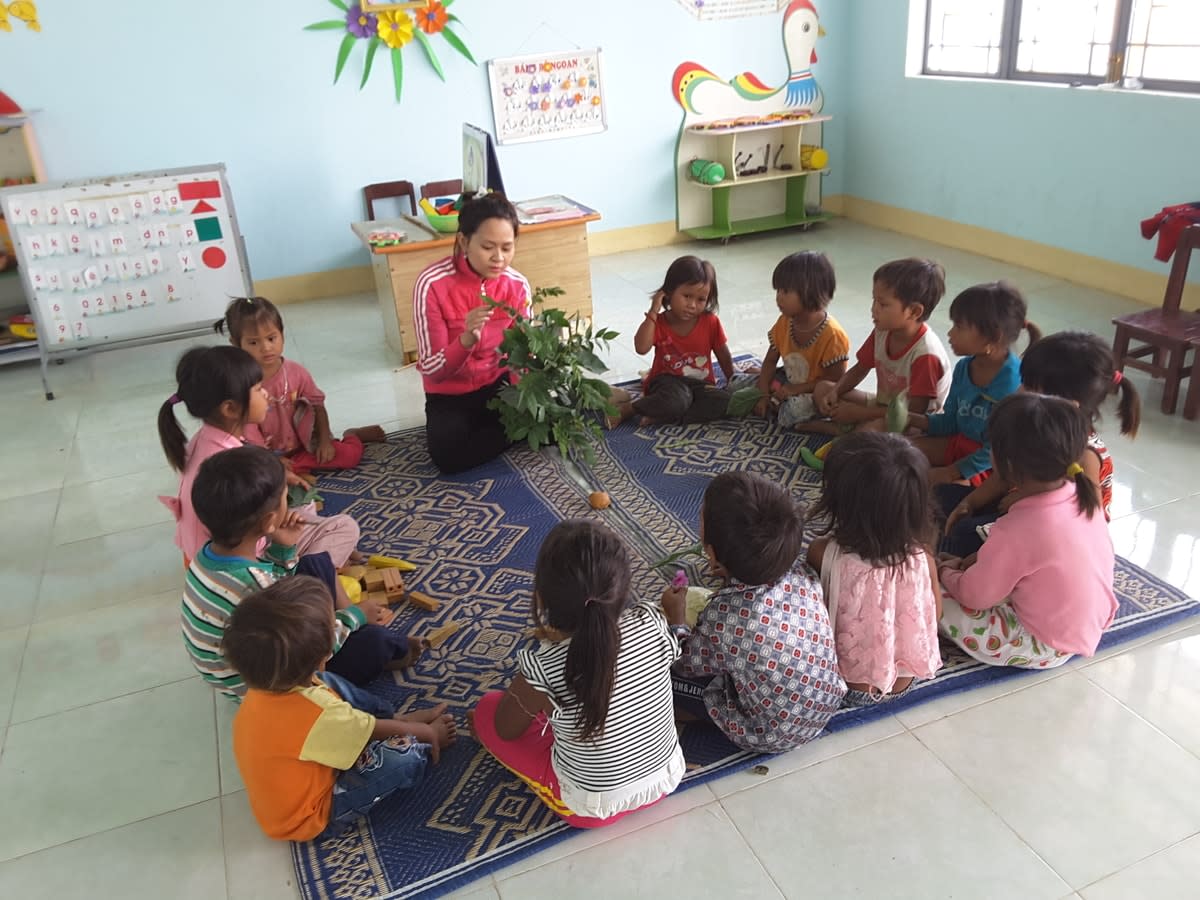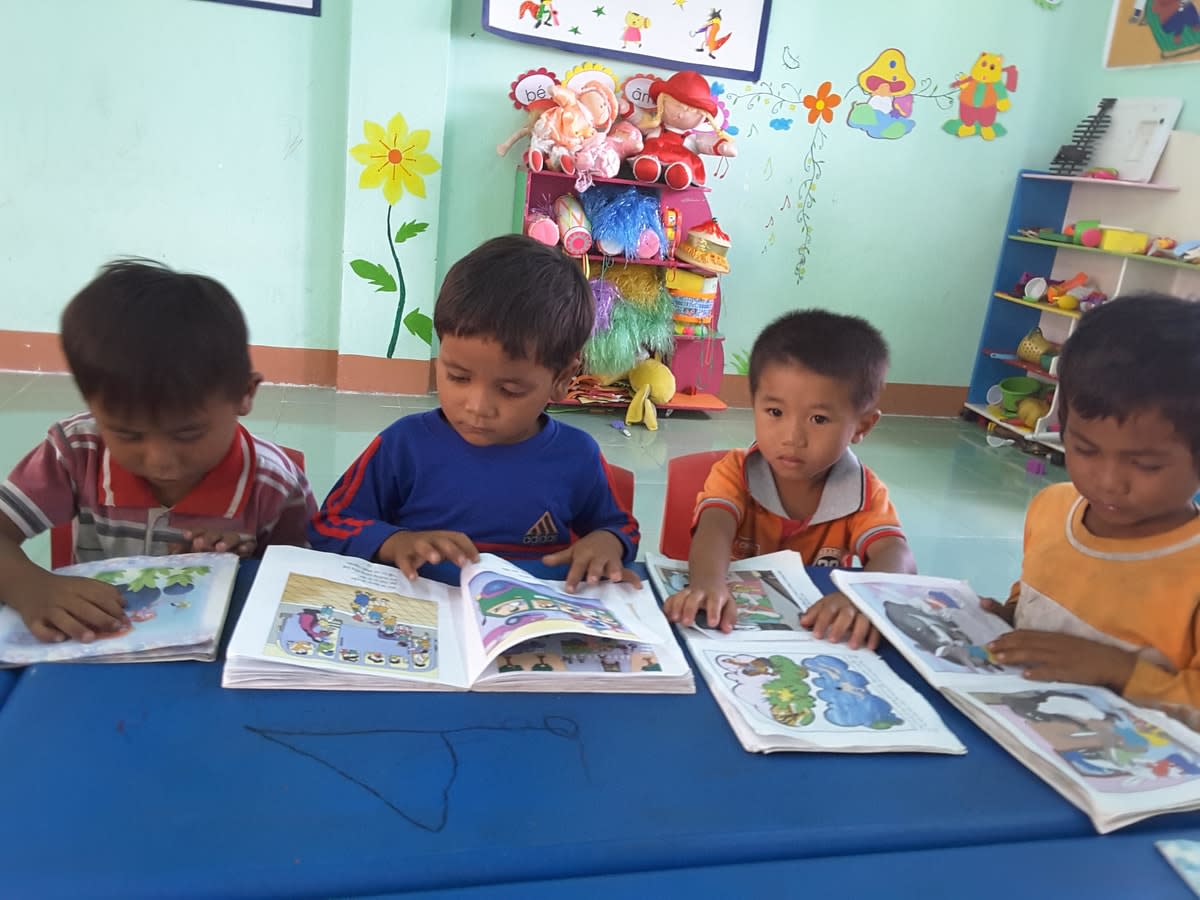The Bahnar are an ethnic group who live in Vietnam’s central highlands. Their distinct language and customs have made it difficult for them to perform well in a Vietnamese-speaking education system.
The aid organisation Plan International set about trying to improve school life for Bahnar children – particularly girls. Its interventions, which were implemented gradually in Gia Lai Province, celebrated Bahnar culture and language, encouraged community involvement in local schools, and emphasised creativity and social play in the early primary years.
Before Plan Vietnam introduced its program, teachers working in the highland schools adopted a very formal teaching approach, delivering programs in Vietnamese to children for whom Vietnamese was a second language. The children sat passively in rows, while their access to books and play materials was limited.
Over a period spanning 2016-18, teachers in the highland schools were trained by the Plan Vietnam group to implement a more child-friendly approach to teaching.

Classroom tables were arranged in groups so the children could cooperate with each other. Local Bahnar people were invited to talk about the Bahnar way of life, and to support the teacher. Children were able to reach for the books and equipment freely.
Outside the classroom, the children were proud when the teacher visited their family, and talked to their parents about their progress. Those teachers who didn’t speak Bahnar were encouraged to learn.
School became integrated with the community’s life. With more emphasis on young girls taking part in education they flourished, while their parents’ aspirations for their future and life goals expanded.
Plan Vietnam needed to find an independent team of academics to assess its intervention before the program could be continued and introduced elsewhere. Researchers from Monash Education proposed an evaluation method that has since attracted international interest – it’s now considered an exemplar of how educational academics can work with non-government organisations.
Aim to empower
Team leader Professor Marilyn Fleer said the Monash team’s idea was not to simply fly in and fly out – as external consultants are known to do – but to empower the Bahnar people themselves to work with the researchers in evaluating the Plan program.
“These communities are very poor,” says Professor Fleer, “and the mountains, the highlands are a very sensitive area. We all needed special approval and visas to work with these communities.”
The five-member Monash team did more than evaluate the Plan program – it also added value to it. In the first phase, workshops were held with parents and community members in which Plan’s educational model, and the researchers’ role as evaluators, was explained. The community in turn was invited to express what was important to them, and what they hoped the program would achieve with the support of the Monash researchers. They were then invited to take photographs and videos of their school to record the changes taking place.

The Monash team members didn’t speak Vietnamese or Bahnar, but could easily “read” the photos. The pictures allowed the researchers to track how the classrooms were being reconfigured – what was on the walls, where the children sat, how they worked together.
“We were generating evidence,” Professor Fleer explains.
The researchers then sent their reports to Plan Vietnam, which in turn used the information to “do tailored professional development follow up in the community” where necessary.
Through analysing the data, the Monash team was able to identify the schools and teachers that needed additional support to work with the Bahnar communities.
Parental involvement
Parents were encouraged to contribute. Team member Dr Corine Rivalland explained that parents’ involvement in their education of their children breaks the barriers between home and school leading to children’s academic success.
“As part of the Plan Vietnam program, parents felt more comfortable to come inside the classroom and support the teachers by creating play equipment and teaching resources that particularly reflected the culture of the local Bahnar community.”
Read more: Changing the story for preschool girls
In the second phase of the evaluation, team members Dr Hilary Monk and Dr Rivalland spent a week in Hanoi holding workshops for Bahnar community members, principals from the schools in the program, as well as Plan researchers and personnel. The aim was to develop culturally appropriate tools that would be used to evaluate the program’s educational impact. The tools included literacy, numeracy, writing (or mark-making), community walk and talk, and social play for children making the transition from pre-school to primary school.

The Monash report uses these tools to compare Bahnar schools where the Plan program was operating, to Bahnar schools where it was not. The team found that children in the Plan schools made drawings that were more complex and creative, demonstrated growing levels of concentration and imagination in social play, and were developing the ability to think abstractly.
"Parents felt more comfortable to come inside the classroom and support the teachers by creating play equipment and teaching resources that particularly reflected the culture of the local Bahnar community.”
One of the tasks involved asking children to walk through the community, taking pictures of what they liked and what they didn’t, and to explain the reasons why. The children from the Plan programs were more confident and articulate when expressing their preferences.
In the final evaluation phase, the “Voices of Children” were captured in child-friendly reports recording the children’s engagement with the program. Each report was specific to a highland community, and was written in a plain, child-friendly style so that the reports were accessible to children and their families.

Monash team member Dr Liang Li says it was rewarding talking to the children about their impressions of school, captured in the reports. “We could see that the children and their families were excited about the reports; they really liked them and valued the work done by Plan and Monash.”
One illustrated page showed the children sitting in a circle with their teacher on the floor. It had the caption: “Group time is something new. We now gather, sit together and learn. We all love it!”
Another page shows the children in the playground and reads: “Usually we have to sit in the class or are told what to do during play. Now we have time for free play.”
Program extended
The Plan program began in seven communities; after the evaluation results were shared with the government, it was extended to 200 communities. In addition, the research model of collaboration between universities and NGOs such as Plan International has been recognised and published as a case-study exemplar for development research, by the Research for Development Impact Network, a collaboration between the Australian Council for International Development and Australian universities.
The Monash research team consisted of Professor Marilyn Fleer, Dr Corine Rivalland, Dr Hilary Monk, Dr Liang Li and Dr Gloria Quinones from Monash University Faculty of Education, and Professor Helen Hedges from the University of Auckland, New Zealand.
Hilary Monk was a Monash University lecturer and researcher at the time of featuring in this article.









